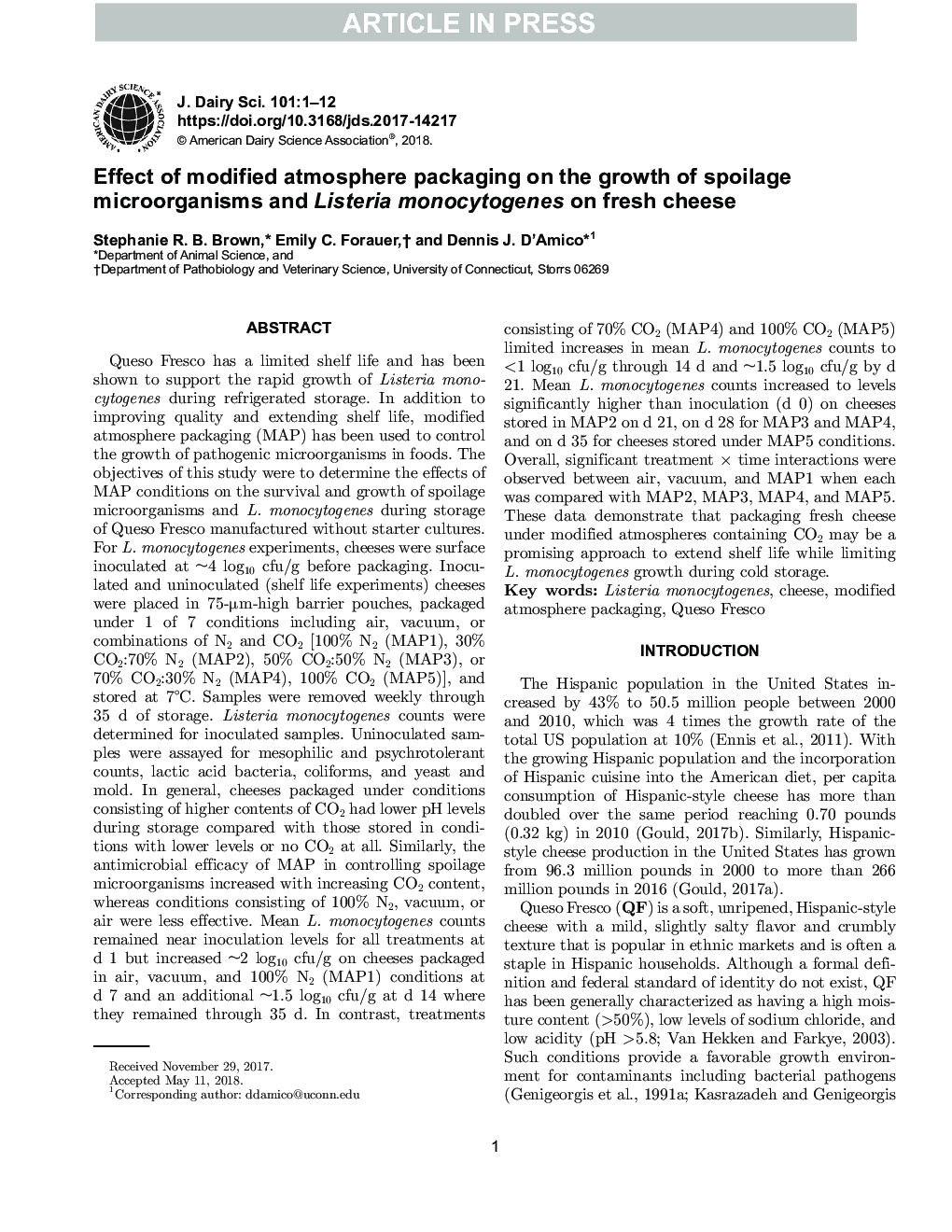| کد مقاله | کد نشریه | سال انتشار | مقاله انگلیسی | نسخه تمام متن |
|---|---|---|---|---|
| 8956440 | 1646155 | 2018 | 12 صفحه PDF | دانلود رایگان |
عنوان انگلیسی مقاله ISI
Effect of modified atmosphere packaging on the growth of spoilage microorganisms and Listeria monocytogenes on fresh cheese
دانلود مقاله + سفارش ترجمه
دانلود مقاله ISI انگلیسی
رایگان برای ایرانیان
کلمات کلیدی
موضوعات مرتبط
علوم زیستی و بیوفناوری
علوم کشاورزی و بیولوژیک
علوم دامی و جانورشناسی
پیش نمایش صفحه اول مقاله

چکیده انگلیسی
Queso Fresco has a limited shelf life and has been shown to support the rapid growth of Listeria monocytogenes during refrigerated storage. In addition to improving quality and extending shelf life, modified atmosphere packaging (MAP) has been used to control the growth of pathogenic microorganisms in foods. The objectives of this study were to determine the effects of MAP conditions on the survival and growth of spoilage microorganisms and L. monocytogenes during storage of Queso Fresco manufactured without starter cultures. For L. monocytogenes experiments, cheeses were surface inoculated at â¼4 log10 cfu/g before packaging. Inoculated and uninoculated (shelf life experiments) cheeses were placed in 75-µm high-barrier pouches, packaged under 1 of 7 conditions including air, vacuum, or combinations of N2 and CO2 [100% N2 (MAP1), 30% CO2:70% N2 (MAP2), 50% CO2:50% N2 (MAP3), or 70% CO2:30% N2 (MAP4), 100% CO2 (MAP5)], and stored at 7°C. Samples were removed weekly through 35 d of storage. Listeria monocytogenes counts were determined for inoculated samples. Uninoculated samples were assayed for mesophilic and psychrotolerant counts, lactic acid bacteria, coliforms, and yeast and mold. In general, cheeses packaged under conditions consisting of higher contents of CO2 had lower pH levels during storage compared with those stored in conditions with lower levels or no CO2 at all. Similarly, the antimicrobial efficacy of MAP in controlling spoilage microorganisms increased with increasing CO2 content, whereas conditions consisting of 100% N2, vacuum, or air were less effective. Mean L. monocytogenes counts remained near inoculation levels for all treatments at d 1 but increased â¼2 log10 cfu/g on cheeses packaged in air, vacuum, and 100% N2 (MAP1) conditions at d 7 and an additional â¼1.5 log10 cfu/g at d 14 where they remained through 35 d. In contrast, treatments consisting of 70% CO2 (MAP4) and 100% CO2 (MAP5) limited increases in mean L. monocytogenes counts to <1 log10 cfu/g through 14 d and â¼1.5 log10 cfu/g by d 21. Mean L. monocytogenes counts increased to levels significantly higher than inoculation (d 0) on cheeses stored in MAP2 and MAP3 on d 21, on d 28 for MAP4, and on d 35 for cheeses stored under MAP5 conditions. Overall, significant treatment à time interactions were observed between air, vacuum, and MAP1 when each was compared with MAP2, MAP3, MAP4, and MAP5. These data demonstrate that packaging fresh cheese under modified atmospheres containing CO2 may be a promising approach to extend shelf life while limiting L. monocytogenes growth during cold storage.
ناشر
Database: Elsevier - ScienceDirect (ساینس دایرکت)
Journal: Journal of Dairy Science - Volume 101, Issue 9, September 2018, Pages 7768-7779
Journal: Journal of Dairy Science - Volume 101, Issue 9, September 2018, Pages 7768-7779
نویسندگان
Stephanie R.B. Brown, Emily C. Forauer, Dennis J. D'Amico,